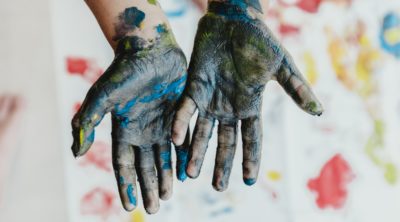
Intermediate colors are formed by mixing two or more colors to create a different hue. Read on to know about this color mixing technique.
Color mixing has no boundaries. When you paint effortlessly, you are like floating kites on the sky, enjoying every degree of freedom. Your painting is your own creation and the colors are manifestation of your imaginative mind. Color mixing techniques can be random or smooth. You can bring out different hues to give unique definition to your painting. If you are a beginner, you need to know the primary, secondary and tertiary colors, at first. Subsequently, you can learn to create different effects by mixing these three types of colors.
What are Intermediate Colors
Firstly, you should have a fair idea about primary and secondary colors. Red, yellow and blue are primary colors. They are also known as fundamental colors and cannot be produced by mixing other colors. Secondary colors are produced by mixing two or more primary colors to get a different combination.
For example, red is mixed with blue to get magenta and blue with yellow to get green. In the color wheel, these colors are located between primary and secondary colors. Intermediate colors are sometimes known as tertiary colors. They are usually two name colors, like, yellow orange, orange red, blue green, etc. So, next time you wonder how intermediate colors are made, just try mixing different hues of primary and secondary colors and to get the intermediate.
List of Intermediate Colors
Randomly mixing different colors produces different types of hues. This technique is also known as color complementation. Merging additive primaries with adjacent secondaries gives rise to a gamut range of intermediate colors.
Just see the effect of colors in the two mediums, light and art, in the next content.

Colour Wheel Pattern

Abstract Art Colors
Handprint Rainbow Art

Rainbow Rose Art
Intermediate Colors of Light
The electromagnetic spectrum is composed of different wavelengths of light. The visible spectrum of light lies between 400 nm to 700 nm, approximately. There are two theories put forward, for reproduction of color. These are additive colors and subtractive colors. The primary colors of light are Red Green and Blue (RGB).
Combination of red and green creates yellow, blue and green creates cyan and mixing red and blue gives magenta. This new combination of colors is known as secondary colors. When these secondary hues or additive primaries are overlapped, they bring out different new combinations, that are known as intermediate colors of light. Infinite numbers of intermediate colors of light can be produced by combining complementary shades.
Intermediate Colors in Art
Intermediate colors in art is also produced by the same technique. These colors are subtle tools to highlight special features or give a new dimension to the art. They have wide application in abstract art where the art itself enjoys total freedom and so its colors. To improve your artistic skills, you can try the trial and error method and get the concept of color mixing technique. Creating intermediate colors and observing the difference between color patterns is interesting. Here are some examples try on your palette.
Examples of Intermediate Colors
By now you might have known the primary and secondary colors in details. Now try combing these and see different textures in your art. To make your concept clear, have a look at the following examples.
Intermediate Colors:
- green + yellow = chartreuse
- red + purple = magenta
- blue + green = aquamarine
- yellow + orange = marigold
- purple + blue = violet
- red + yellow = orange
- green + cyan = aquamarine
- blue + cyan = azure
- red + magenta = fuchsia
- magenta + red = violet
- blue + violet = indigo
- violet + red = violet red
- orange + yellow = yellow orange
- orange + red = vermilion
- orange + purple = russet
- orange + green = citron
- purple + green = olive
Creating intermediate colors is genuinely fun. Just splash a color and merge the other. Get the resultant hue and blend with another. Try this technique to improvise your skills on palette. This way you can even expand your ideas about color and utilize them while giving a form to your imagination.













